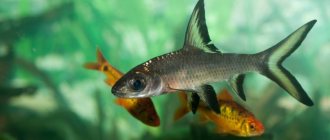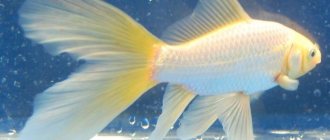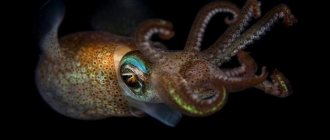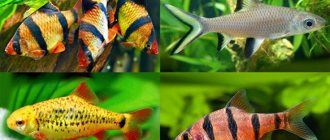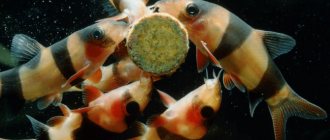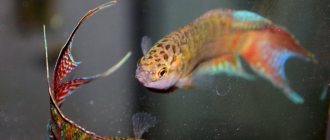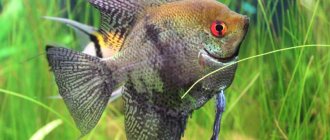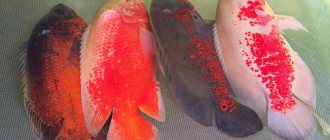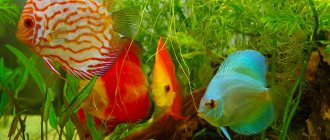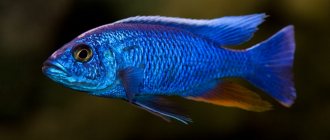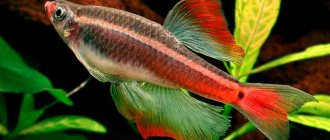Description
Cherry puntius or cherry barb is a species of fish belonging to the class of ray-finned fish and located in the cyprinidae family of carp. Belongs to the endemic (species found only in a certain area and nowhere else) of the island of Sri Lanka. Found in the waters of the Kelani and Nilwala rivers. Prefers clean reservoirs with clear and slowly flowing water. The bottom is most often covered with silt, in which a large amount of vegetation grows.
In the past, the water bodies on the island of Sri Lanka were changed by human activity, and the territories were used for their own needs. This led to the species being listed in the Red Book as being on the verge of extinction. With the help of nature reserves and captive breeding, the population has been restored.
These fish, originally from Asia, have been known to mankind for more than several hundred years. In the European part, their general popularity began in the 1930s. In the USSR they appeared closer to the 1950s.
Appearance
From the name of the species, the color of the fish immediately becomes clear - rich red-cherry. The color reaches its greatest brightness during the spawning period. And also the color changes depending on the physical condition. The color of fish living in natural conditions is much brighter than those bred in captivity. Along the sides there is a dark stripe that stretches from the head to the caudal fin.
These fish grow up to only 5 cm. Their body is elongated and oval with points in the head and tail. The dorsal, pelvic and anal fins do not differ in size or shape, and the caudal fin has the usual forked shape.
There are small mustaches near the mouth, which is why the genus was called barbels.
Breeders have developed a more perfect and beautiful form of cherry puntius - veiled cherry barb. The veiled specimen has long, flowing fins and a more striking coloration.
Behavior
Cherry puntius is a schooling fish. In the wild, flocks of puntius reach a couple of thousand individuals. When kept alone, the color of the fish turns pale and dull.
Behavior towards other representatives is peaceful and non-aggressive. Do not keep them with fish that have veil-like and long fins. The barbs bite them off.
Lifespan
The average lifespan of barbs is 4 years.
Other shapes and similar species
In aquariums you can find unusual artificially bred forms of the cherry barb - albino and veiled (with long fluttering fins and a bright body color). These are more delicate and whimsical fish than the ordinary barb and live much shorter - up to 4 years.
The veil barb does not tolerate the slightest deviations from the recommendations in the composition of the water.
Barbus Ticto (scarlet barb) has a color similar to cherry. These are peace-loving fish that get along best in a small school of 6-7 individuals. The fish are quite active and such a school requires an aquarium of up to 80 liters.
Another similar species is the fire barb. Adults can reach a size of 8-15 cm. They have a bright red color with a golden tint and clear scales. Fins with dark outline.
Feeding
In the natural environment, the diet of fish consists of crustaceans, insects, larvae, and some plants. When keeping a cherry barb in a home aquarium, the fish calmly eat food of any origin. A good diet option would be a combination of live food with a small amount of dry food, such as flakes or granules. Puntius also needs supplements in the form of plant foods, for example, vegetables, nettle leaves, lettuce, spinach, and dandelion.
Puntius are fed small portions a couple of times a day. Remember that cherry barbs are small in size and have a small mouth. Therefore, choose food with small particles or grind the food before feeding yourself. When feeding vegetables or leaves, be sure to scald them with boiling water to kill bacteria and soften food pieces.
Spawning of cherry barbs
It is better to prepare the spawning of cherry barbs in the evening, counting on the morning hours. The signal for the start of spawning can be the entry of natural morning light into the spawning area. It is recommended to close the spawning tank to prevent fish from jumping out during heavy spawning.
Spawning lasts 2-3 hours. One female cherry barb lays up to 200 eggs. After spawning, we remove the protective net, and if plants were used as a substrate, they can be left and carefully removed after the fry swim. If the eggs have been successfully fertilized, the larvae will appear in 2 days, and after another 1 day the fry will swim and you need to be prepared for this moment.
Starter feed
As a starting food for cherry barb fry, it is better to use complete live food: slipper ciliates, rotifers or brine shrimp. The worst, but quite acceptable option would be to feed the fry with boiled egg yolk.
Preparing this food is very simple: hard boil a chicken egg and separate the yolk, cut it in half and rub it over the surface of the yolk with a watercolor brush dipped in water and rinse it in a jar of water. When the microparticles of the yolk settle, drain the cloudy water and add clean water. After the drained water becomes clear, carefully pour the settled yolk particles onto the compressor sprayer for the fry.
Good and useful helpers for cleaning the bottom of the aquarium from uneaten yolk particles will be ampularia snails or a small Ancistrus catfish. These orderlies must be assigned to the fry. From the first days of feeding the fry with yolk, add Daphnia moin. Small newborn crustaceans will become available for consumption already on the 3-4th day of the fry’s life, which will become noticeable by the swollen abdomen.
Later, you can alternate daphnia with grindal, as well as cut and well-washed aulophorus. Growing fry need to be placed in additional aquariums, otherwise their growth will begin to be delayed. It is necessary to move grown fry to adult fish only when the fry reach 1.5-2 cm in size and make sure that no treacherous neighbors are waiting for them in the new aquarium.
You cannot release all the fry at once. To begin with, release only 1-2 fish and, if after a day they are not pursued by adult fish, then you can release the rest. Otherwise, you need to catch and return the fish to their place for further growing or relocate the bullies.
Compatibility
Cherry barbs are famous for their peaceful temperament and get along well with almost all other aquarium inhabitants, especially if they themselves do not show aggression. It is possible to keep fry of other fish together with barbs and not have to worry about their safety. But cherry fish themselves often become victims of attacks from other fish due to their size. For example, the poor compatibility of barbs with territorial angelfish and discus fish. Sumatran barbs should not be kept together either.
A post shared by Pablo Sebastián Elarca (@elarcapetshoplujan) on Jun 5, 2022 at 1:09pm PDT
Sexual Dimorphism
The cherry barb reaches sexual maturity at the age of 6-8 months.
Cherry barb (Puntius titteya) male.
It is not difficult to distinguish females from males, since females are slightly larger than males and are more modestly colored.
Cherry barb (Puntius titteya) female.
Male cherry barbs have a bright reddish abdomen, while females have a lighter flint-yellow abdomen. In addition, females are plumper than males and have a reddish dorsal fin with two arched black stripes.
Reproduction
Puberty occurs at six months, and individuals are ready to reproduce at 9-12 months. To reproduce cherry puntius, there must be 2 males per female. To breed barbs, you will have to create more favorable conditions in the aquarium or place several fish in a separate spawning tank. A week before spawning, the fish are fed heavily and the water temperature is increased. It is advisable to ensure a complete absence of stress. When setting up a spawning tank, you should lay a net on the bottom through which the eggs will fall, and place vegetation on top of the net.
Habitats in nature
Under natural conditions, this species is most often found in rivers in Sri Lanka and Ceylon. These fish prefer shallow streams and quiet, shady pools, which serve them as natural shelters and protection from various enemies.
Schools of the cherry barb have chosen dense thickets of aquatic plants at depth, because their bright color makes them easy prey for larger and more predatory fish that actively prey on the cherry barb.
Their natural population has greatly decreased due to their great popularity among aquarists, and the breeding process of the cherry barb is under threat. Therefore, in some countries there are now nurseries that breed cherry barbs.
Diseases
Resistance to most diseases is a distinctive feature of barbs. They have a strong immune system that helps them survive in adverse conditions. With improper and inappropriate care, barbs can contract various diseases.
- Lack of aeration system. There are fish that are able to breathe air at the surface, but most species require aeration.
- Lack of a filter and rare water changes in the aquarium.
- Incorrect ratio of aquarium volume to number of fish.
- Poor quality food, which is most often contaminated with infections.
- Failure to comply with hygiene rules, entry of infected plants and decorations.
- No quarantine for purchased fish.
- Incorrect organization of spawning.
The most common diseases affecting the body of cherry barbs:
- White-skinned.
- Gill rot.
- Rubella.
White-skinned
White-skinned is an infectious disease that affects the body of the fish, the color of the pet changes. Its skin becomes whitish or yellowish near the caudal fin and on the back.
The disease easily spreads throughout the aquarium from one sick fish to another, so if you notice signs of the disease, immediately begin treatment and remove healthy fish. Secondary symptoms are considered
- Lethargy of fish.
- Decreased appetite.
- The individual is on the surface of the water.
- Problems with coordination due to disruption of the nervous system.
Mr. Tail Recommends: Aquarium Basics
When creating comfortable conditions for the cherry barb to live in an artificial reservoir, it is necessary to take into account the following nuances:
- The size of the aquarium is from 50 liters per 10 individuals.
- Use settled water, with a temperature of about +25 °C, hardness 2-19 ° dH, acidity 6.5-7.3 pH. A weekly replacement of a third of the fluid volume is required.
- Soil is a dark-colored substrate of small or medium fractions.
- Provide good aeration and filtration.
- They provide access to daylight, and if it is absent or insufficient, they are equipped with an additional source of lighting.
- Driftwood, caves, broad-leaved plants, etc. are used as decoration.
- The landscaping is increased and dense, creating shade and shelter while leaving areas for free swimming.
Suitable vegetation:
- limnophila;
- bacopa carolina;
- aponogeton;
- lagarosiphon curly;
- Vallisneria.
- pennywort;
- hygrophila.
Reviews
Cherry barbs are considered the most calm and peaceful inhabitants of the barb genus. Breeders note that their pets are not known for being destructive or excessively whimsical and selective. These inhabitants are omnivores, so there are no problems with feeding. There are no particular problems with reproduction either. And everyone also notes the exquisite beauty of this fish, its red-cherry color.
Neighborhood with other inhabitants
Barbs themselves are quite cocky, so it is better to keep them in a species aquarium. But this statement does not apply to the cherry barb. “Cherry” is ideal for keeping in a community aquarium. It is so adequate that it does not affect even those with veiled tails and fins. Another thing is that he needs the same peaceful, but playful neighbors.
The only thing that is definitely not suitable is all kinds of predators and fish larger than it. A small barb will definitely become “dinner” for cichlids and other “big guys”. Even angelfish, especially large ones, will not give him a quiet life.
